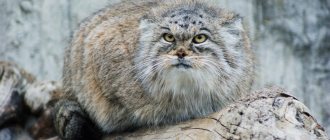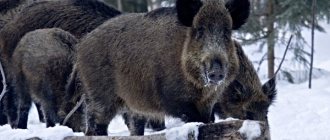Manul is a representative of the wild cat world, which, according to global network ratings, is one of the most popular exotic animals. Unusual long hair, small ears pressed to the head, and the intelligent look of amazing eyes made this cat a real Internet star.
Do not forget that this is not a breed of cute pet, it is a wild predator that is unlikely to ever be able to get along with a person.
Kinds
The Pallas' cat species includes three subspecies. They have an almost identical appearance and differ from each other only in coat color.
| Subspecies name | Peculiarities | Spreading |
| Regular (Siberian) | The color is dominated by gray and pale yellow shades | Mongolian steppes, Transbaikalia, northern China |
| Central Asian | The coat has a buffy-red hue, the longitudinal stripes in the back of the body are reddish-brown | Iran, Afghanistan, some Central Asian countries |
| Tibetan | The color is darker with a predominance of gray shades; in winter the fur becomes lighter | South Asia, Tibetan Plateau |
Appearance of the breed
Pallas' cats are large and fluffy cats with a powerful, muscular and strong physique:
- The head is medium in size, wide in shape, with small ears, slightly rounded at the ends, placed on it, like toy ears. Flattened muzzle, fluffy and long hair on the cheeks.
- The eyes are amber in color, slightly convex. The pupils do not react to color. This phenomenon is observed in most representatives of the cat world.
- The legs are short, but this is compensated by their power and muscularity.
- The tail is medium in length, very fluffy.
- Color – gray with white tips. The body is mottled with black stripes that stretch from the tail across the entire rump and across the body. There are dark stripes on the cheeks as well.
The size of the animal, despite its external massiveness, is quite compact. The weight of an adult is 2-5 kg. Compared to other powerful breeds, for example, the Maine Coon or the Norwegian forest cat, the Pallas cat is significantly inferior in size. The largeness and dimensions of the appearance are given by very fluffy wool.
Where does it live?
The habitat of the Pallas's cat consists of several zones isolated from each other. This feature of the distribution of the wild cat is associated with the animal’s attachment to certain landscapes and the almost complete extermination of the species in steppe regions with vast open spaces.
Currently, isolated areas inhabited by the Pallas's cat are located in the countries of Central and South Asia: Kazakhstan, Kyrgyzstan, Tajikistan, Nepal, Pakistan.
On the territory of our country, three zones of distribution of the species have been identified. They are located in the eastern part of the Transbaikal Territory, the Republic of Buryatia and the southeast of the Republic of Tyva.
Where does he live?
The natural habitat of the Pallas's cat extends to areas with a harsh continental climate and low humidity levels. The wild cat tolerates the continental climate well with sudden temperature changes and cold temperatures down to -40 degrees, but at the same time avoids areas where the snow cover exceeds 10 cm in the winter months.
Animals prefer landscapes dominated by treeless hills, hills, rocky steppes, low cliffs and foothills covered with grass and shrubs. Pallas' cat habitats have been recorded at altitudes of up to 4800 m above sea level.
In lowlands and forests with dense vegetation, wild cats are practically not found.
Small, but a beast: wild cat Pallas
The manul cat is the smallest and fluffiest of the wild felines. A good fur coat is vital for this animal - it helps the cat feel comfortable in a sharply continental climate. This is when in winter the temperature drops to -50 degrees, and in summer it rises to +50.
Manul is a very beautiful, but very wild cat
History of discovery
Scientists call the Pallas's cat one of the oldest species of predators on our planet - its history goes back at least twelve million years! The small, inconspicuous cat managed to survive such monsters as, for example, the saber-toothed tiger, without undergoing any special evolutionary changes.
The word “manul” has Turkic roots, but what it means is not known for certain. Since ancient times, this is how the Mongols dubbed the animal living in their neighborhood - many peoples, if they did not deify this small mysterious beast, then always treated it with reverence.
The little Pallas's cat is a contemporary of the saber-toothed tiger
The ancient predatory cat, oddly enough, remained unknown to science until the end of the eighteenth century, and specifically until 1776, when it was described by the outstanding German naturalist Peter Pallas. At that time, the German scientist was in Russian service and participated in large-scale Siberian expeditions. In honor of its discoverer, the Pallas cat received one of its names - Pallas's cat.
For a long time, the Pallas cat was classified as a representative of the genus Felis and the closest relative of the wild cat, but a deep study of species characteristics prompted scientists to create a separate genus in the cat family, Octolobus, especially for the Pallas cat.
Here's a manul - video
Reproduction
Sexual maturity in males and females occurs at the age of 10-11 months. The rutting period usually occurs at the end of February and beginning of March. Clashes may arise between males for the right to cover the female. After the mating season is over, the animals return to their territories. Feeding and raising the cubs is carried out exclusively by the female.
During pregnancy, which lasts 7-8 weeks, the cat prepares a place for future offspring. She brings from 2 to 6 kittens at a time. Until 10-12 days, babies remain blind and are completely dependent on their mother. The female feeds the cubs with milk for 3 months. Then the older kittens try to hunt on their own, remaining with their mother for several more months. Before the onset of puberty, young animals leave the female and look for a free area for hunting.
OCELOT
How to hunt
Pallas' cats are quite slow and clumsy, so during hunting they prefer a wait-and-see tactic. They set up ambushes in trees, among grass or stones and attack the victim with one quick and accurate throw.
Typically, wild cats stalk prey near burrows or trails leading to feeding areas. Pallas' cats can stick their paws into shallow holes and reach small animals hiding there.
What does it eat?
The wild cat hunts small rodents (marmots, hamsters, voles, jerboas), pikas, and squirrels. The animal's diet includes several species of birds, mainly nesting on the ground. Pallas' cats can attack hares.
In the absence of the usual food supply, cats eat large insects: crickets, grasshoppers, locusts.
Before the onset of cold weather, the animal consumes more food, and in winter it may eat less often than usual.
Features of character and lifestyle
Photo: Pallas' cat
The character of the Pallas' cat is complex. The animal is extremely secretive and cautious. Like other representatives of other cat cats, manulas are loners. Of all the cats that exist in the wild, the Pallas' cat is the slowest and most incapable of moving quickly. Manul, like other predators, loves the night time. Despite the fact that this mammal can hunt during daylight hours, Pallas’ cat prefers to sleep during the day. Due to individual characteristics, such as slowness and deliberation, the Pallas's cat often has to guard its prey near the hole. The color of a wild cat's fur acts as camouflage.
The Pallas' cat hides from enemies in gorges, on rocks or in holes. This cat makes its cozy den from old badger or fox holes, or adapts itself in rock crevices and small caves. This is what helps the Pallas cat to go unnoticed if he hides. Manul is the slowest among wild cats. When irritated or aggressive, Pallas' cat emit loud sounds that have many similarities with the sounds of an owl.
How many Pallas' cats are left on earth?
According to the World Wildlife Fund (WWF), at the end of 2016, the total population of Pallas's cat numbered about 12 thousand individuals. In our country, most of these rare wild cats live in the Chita region. According to experts, there are from 2 to 2.5 thousand animals in the region. About 200-250 wild cats live in Buryatia and Tyva.
Counting the number of animals complicates their secretive lifestyle. However, even without an accurate determination of the number of Pallas's cats, it is clear that in recent decades there has been a gradual and stable decrease.
Habitat
A predatory mammal, the wild Pallas's cat mainly lives in rocky uplands, treeless slopes and intermountain basins from Iran and South Transcaucasia to Transbaikalia, North-West China and Mongolia, in Central and Central Asia. The largest numbers are observed in areas with little snow.
In Russia, the Pallas cat lives in the steppe zone of the Chita region, in the forest-steppe regions of Buryatia, in Tyva and Altai.
Why is the Pallas's cat listed in the Red Book?
Currently, the species is in the register of the International Red Book, and is also included in the Red Book of Russia with the status of “close to vulnerable”. Hunting a wild cat is prohibited in all regions of its habitat.
There are several reasons that negatively affect the number of manuls:
- poaching for fur;
- falling into traps and traps placed on other animals;
- increase in the number of natural enemies;
- unfavorable weather conditions causing a decrease in food supply;
- fires that force animals to move to less favorable regions;
- eating mice and other pests treated with pesticides;
- epizootics.
SNOW LEOPARD
Interesting facts about the manul
- All attempts to tame a wild cat ended in failure. Even kittens that have contact with humans from the first days of life begin to show the instincts of a wild animal at the age of 3-4 months. Pallas cat not only cannot be domesticated, but also does not tolerate life in captivity well. Animals brought to zoos often suffer from various infectious diseases, especially toxoplasmosis. This is due to the lack of an immune response to pathogens. In their natural environment, Pallas' cats practically do not encounter infectious pathogens, which did not allow the animal to develop reliable defense mechanisms. A high mortality rate is also observed among kittens born in captivity.
- The fur of the Pallas's cat is second only to the Arctic fox, chinchilla and sea otter in thickness: up to 9 thousand hairs grow on every square centimeter of the predator's skin. To avoid damaging the animal's fur, hunters used traps.
- Manul is not the only wild cat. There are several other species of small cats in the world that have never been domesticated. These include the jungle cat, which lives in the southern regions of Asia, the forest cat, which can be found in the Middle East and Africa, the Amur cat, common in the Far East, as well as the steppe cat, which prefers to settle in the desert regions of Asia and Africa.
- Employees of several Russian nature reserves are trying to preserve the endangered species and increase the population size: Sayano-Shushensky, Daursky, Altai State Biosphere Reserve. Observing Pallas' cats in protected areas also allows us to study in more detail the animal's lifestyle and behavioral characteristics.
Natural enemies
Manul has quite a lot of natural enemies, including food competitors. These include birds of prey, common fox, and so on.
Natural enemies of the Pallas cat are:
- wolves, the number of which has been increasing recently;
- dogs (both wild and herding);
- falcon birds;
- eagle owls;
- poachers.
The manul is not a very fast and impetuous animal, so it is difficult for a cat to escape from someone who is purposefully pursuing it. If the enemy takes him by surprise, in most cases the animal has to say goodbye to life.











